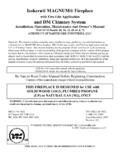Transcription of 10. Standards for materials used in plumbing systems
1 HEALTH ASPECTS OF PLUMBING464710. Standards for materials used in plumbing StandardsStandards are sets of rules that outline specification of dimensions, design of operation, materials and performance, or describe quality of materials , products or systems . These Standards should cover the performance expectations of the product for particular applications, as well as, in the case of drinking-water con-tact, the chemicals that may be leached from the product into the water. The intent of Standards is to provide at least minimum quality, safety or performance specifications so as to ensure relatively uniform products and performance, and to remove ambiguity as to the suitability of certain commercial products for par-ticular applications.
2 They reduce the risk of error by installers, and also provide assurance to the plumbing system owners. Standards also provide direction to manufacturers in respect to the expectations of the products that they produce. Internationally accepted Standards provide economies to both the manufacturer and the user by reducing the number of products of the same type that must be produced. Standards may be developed by industry, non-profit organizations or trade associations, as well as national or international bodies. The existence of credible Standards and certifiers relieves the regulatory authority of the need to develop its own case-by-case Standards and product assessment existence of a standard does not always ensure that all available products meet a specific standard.
3 In order to be confident of uniformity in a product there must be checks and balances. This is accomplished by assessment conform-ity. Assessment conformity, product listing and certification all have the same meaning. Simply stated, it means that a product, material or device has been tested and verified to meet the specification that has been developed. There are at least three types of certification: where the manufacturer or seller self-certifies and guarantees the product by warranty or contract; where the manufacturer or seller obtains verification by a contract laboratory.
4 Or where the specific com-mercial product (not just the class of product) has been evaluated by a credible independent third-party testing or certifying organization that is in no way related to or a part of the manufacturer or seller, and which has a system for policing the validity of its conformity, by any name, means that a product, service, material, system, device or component has undergone testing to ensure it meets the HEALTH ASPECTS OF PLUMBING4647intended standard for such product, material, system, device or component.
5 There are several organizations that perform assessment conformity and, in most cases, if a specific product, material, system, device or component meets a designated standard, the testing organization may allow placement of a mark or logo of the organization on the product, material, system, device or component to certify that the relevant standard was successfully Products and materials used in Standards for plumbing products and materialsThe durability of a plumbing system is dependent on the quality of its compo-nent parts and the assembly skills of those who install it.
6 No plumbing system, however well designed, can be expected to operate safely or hygienically if the products or materials used are unsatisfactory. The inverse is also true if the best-quality products or materials are used but are installed incorrectly, the system will be a industrialized countries have national Standards or codes that set out the minimum requirements for the material specifications, design and use of specific plumbing products. However, plumbing codes of practice vary considerably according to the extent to which they specify the detailed Standards for plumb-ing products and other matters.
7 Some countries take the view that the level of detail should be minimized, whereas others are very prescriptive. However, even prescriptive codes should allow for the introduction and innovative use of prom-ising new products, materials and installation practices without undue delay. Countries that are members of the International Organization for Standardization (ISO) may choose to adopt the ISO framework as a minimum standard set for plumbing products and materials . WHO Guidelines for Drinking-water Quality should be used as reference in decisions concerning health-related matters.
8 Several national and international Standards and certifying organizations utilize and expand upon those basic principles by identifying specific products that comply. It is important to ensure that commonly used plumbing products and materials are of the same type, at least throughout a country, to take advantage of economies of scale in manufacturing and to ensure easy process of certification of quality of plumbing products may necessitate the setting up of testing establishments where products can be assessed. In many cases it will be more economical to simply adopt an existing qualified Standards and certification programme that already has international acceptance.
9 This will also avoid unnecessary proliferation of Standards . Product certifiers and their testing facilities must be of the highest standard and subject to external application of suitable materials and products must be supported by adequate levels of training of plumbers who use them so that they can identify and use only appropriate products. 10. Standards FOR materials USED IN plumbing SYSTEMSHEALTH ASPECTS OF Selecting suitable products Numerous Standards and certification bodies exist nationally and internation-ally, so it may not be necessary for a country to develop a unique set of Standards .
10 It could decide to adopt one of the existing systems and require that products are certified to meet that system s requirements. In judging a product or material, the regulating authority (or certifier) must consider factors such as the following: Is the product or material under consideration suitable for the application or purpose? Will it be harmful to the health of the community in its normal use? Is there a risk of these materials being released into the environment ( the water) in the first instance or after the working life of the product or material has expired?















